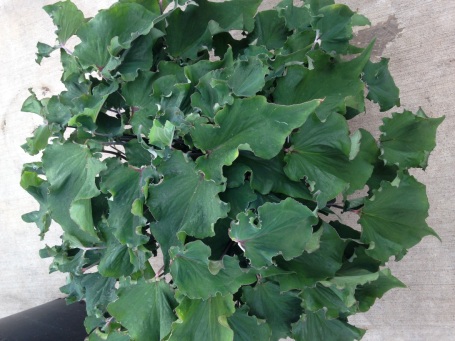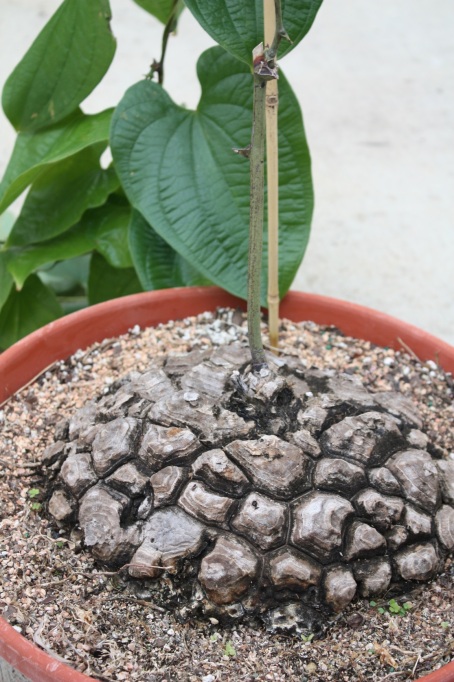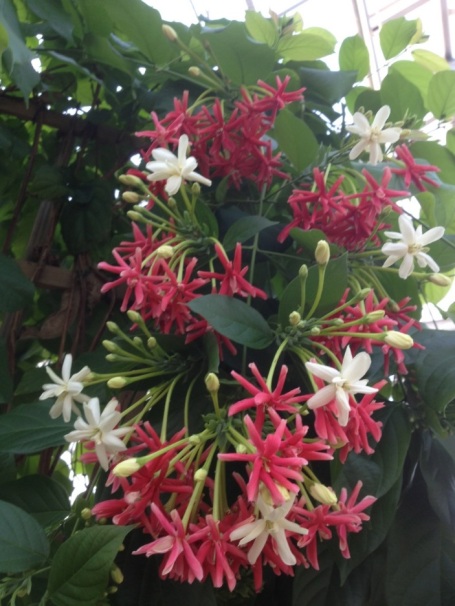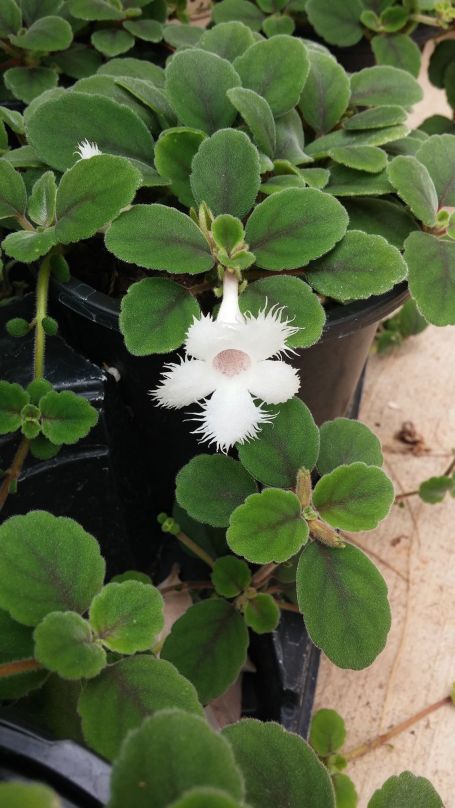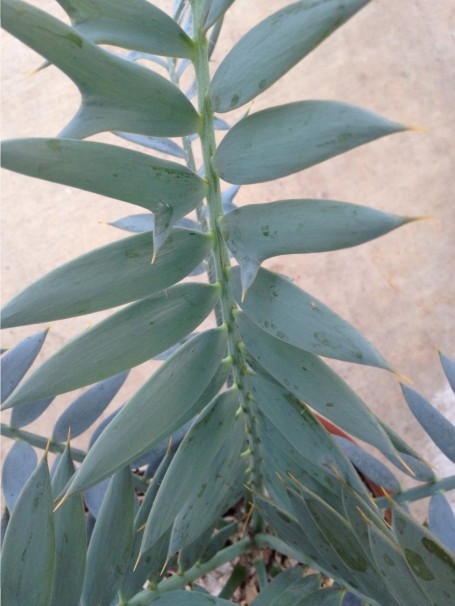Posts tagged ‘living collections’
A New Day, a New Database: Smithsonian Gardens Living Collections Management
World-class orchid collections like the one at Smithsonian Gardens are more than an assemblage of pretty flowers. A lot of work goes on behind the scenes like maintaining good plant culture, regular and judicious watering, and dealing with insect pests and viruses. Another aspect of a well-kept collection is vigilant record keeping and data management.
There are several collections information systems (CIS) in use by botanic gardens that keep track of accessioned plant material. In the past, Smithsonian Gardens used a relational database tailored specifically to orchid collections for this purpose. This program worked well for many years but our growing online presence, digitization and IT requirements, and opportunities to expand SG’s plant collections prompted us to search for a more robust system.
In November 2015, Smithsonian Gardens switched to a botanical collections database with a more flexible framework. This new framework enables us to expand our plant records to encompass gardens surrounding the Smithsonian museums, in addition to managing our living collections of orchids and trees. Using this new tool to accession “unofficial” collections such as SG’s tropical plants will improve our horticulturists’ ability to track plant usage, longevity, and vitality.
Visitors to the Smithsonian will also benefit from this database transition. As Smithsonian Gardens tracks new plants in its gardens, staff will be able to plot their locations on a map, create tours, and compile images and other plant data on SG’s website. For on-site visitors, this will be an invaluable trip-planning tool; for online visitors, this will be a fantastic way to explore plants on the Smithsonian campus from afar.

Draft view of Smithsonian Gardens’ living collections mapping and information page.
The switch to a more flexible database also allows SG to better integrate its collections information with existing Smithsonian IT systems. This compatibility enables automatic syncing of collection images between the plant database and the Smithsonian’s main Digital Asset Management System rather than having to link the images separately in both places. Cross-talk between the systems cuts out redundant steps from our previous workflow and frees up collections staff to work on other projects. In addition, the process used to update collection images and information to the online Smithsonian Collections Search Center is more streamlined.

Screenshot of Orchid Collection images in the Smithsonian’s main Digital Asset Management System.
SG’s living collections team is currently cleaning up and enhancing the migrated data. With over 30,000 records of both living and historic plant assets, there is a lot of verification and editing to accomplish. This fall the focus will shift to the Smithsonian Gardens Tree Collection, the other living collection entrusted to our care. Our goal is to integrate Tree Collection data from an existing database with accession records in the new database, while maintaining the ability to track tree locations across more than 180 acres of grounds through mapping software.
Smithsonian Gardens is excited to grow its living collections management program. The implementation of a new database is just a first step, but it paves the way for future progress and enables more efficient and effective management of the Smithsonian’s living plant collections for the benefit of both on-site and virtual visitors.
-Julie Rotramel, Living Collections Specialist, Smithsonian Gardens
On Display: Spectacular Spider Orchids
The Smithsonian Gardens Orchid Collection contains an amazing assortment of species and hybrids. I come to work each day with great anticipation of what new marvel has unfurled overnight. I am never disappointed. Our interiorscape staff selects the most stunning plants for our orchid display cases outside the Warner Bros. Theater on the first floor of the National Museum of American History (NMAH). This week’s display features a group of orchids from one of my favorite genera, the fascinating Brassia.

Brassia Rex ‘Sakata’ from the Smithsonian Gardens Orchid Collection on display at the National Museum of American History.
Better known as spider orchids, Brassias are beloved for their long, narrow, ribbony sepals and petals. One of the orchids currently on display is Brassia Rex, a hybrid of Brassia verrucosa X Brassia giroudiana, which is known to have greater vigor and larger flowers than either parent. Created in the 1960s by the venerable orchid breeder Goodale Moir, this exceptional hybrid is a wonderful addition to every collection that has space for it. Beware, however, as it can grow into a monstrously large plant.
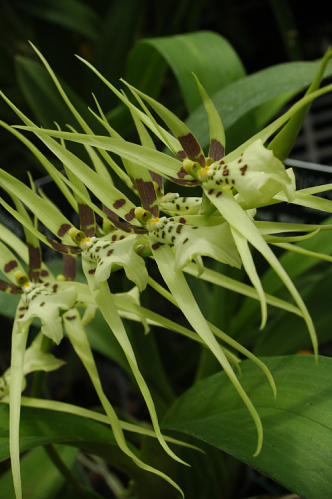
Brassia Rex, 2009-1460A, Smithsonian Gardens Orchid Collection.
It has long been believed that Brassias evolved flowers which—through a strategy known as brood site deception—mimic the appearance of spiders in order to attract female parasitic wasps of the genera Pepsis and Campsomeris that target spiders as hosts on which to lay their eggs. This ‘imitation’ strategy is evident in many types of orchids that use flower smell, color, and texture to appear to be suitable places for pollinators to deposit their progeny. Ecologists in Central America, however, have recently noted that while parasitic wasps do indeed visit Brassias and pollinate them, they do not appear to lay eggs on these orchids. As a result, this finding disproves brood site deception as the reason for Brassias’ spider-like appearance. While the true reason for the spider orchid’s form remains unknown, discussion at a recent orchid conference brought up the possibility that these wasps simply like the look of these flowers.
This raises a fascinating question I’ve been mulling over recently: Is it possible that there is an aesthetic component to orchid evolution? Charles Darwin thought this to be the case and pointed to the sexual selection of mates in various animal species as evidence. Perhaps pollinators also select showy flowers such as Brassias for their ‘attractiveness.’ This question has yet to be answered and is just one of the many reasons I find the mysterious field of orchid ecology so fascinating.
-Tom Mirenda, Smithsonian Gardens Orchid Collection Specialist
Three Cheers for Spring: What’s Blooming in the Smithsonian Gardens Orchid Collection
It’s finally spring! Today marks the fifth day past the Spring Equinox and it seems like nature is as ready as we are for the change in season. Around the city cherry and magnolia trees are bombarding the city with their pink blossoms and fresh fragrance. Splashes of color from daffodils and pansies are everywhere. Though the season’s change is much more gradual in our orchid greenhouses, this time of year still finds unparalleled variety and interesting stories to tell in our species collection.
This first species was part of a donation we received last summer. It entered our collection as Acianthera aculeata, but now that we have seen the plant in bloom, it doesn’t quite match the type description for the species. A proper identification will require more research for our orchid curators.
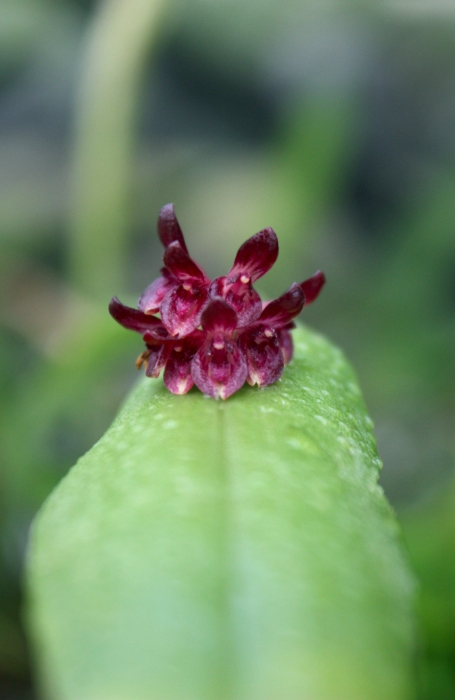
Acianthera sp.
Regardless of its specific name, one characteristic I find fascinating about this orchid and many other Pleurothallids is that the flower spikes arise from the base of the leaf rather than closer to the root structures. This makes the flowers appear to grow right on the leaf surface, which has an interesting effect. Many Pleurothallids are thought to engage in brood site deception, and it can be speculated that these small, wine colored flower umbels mimic the perfect egg-laying site for the plant’s pollinators.
Mediocalcar decoratum is a mat forming epiphyte found in the cloud forests of New Guinea. The miniature orange and yellow bell-shaped flowers are scattered evenly throughout the foliage like someone’s lost candy corn and lend a generally cheerful aspect to the plant. This may be why it is commonly known as the Charming Mediocalcar.
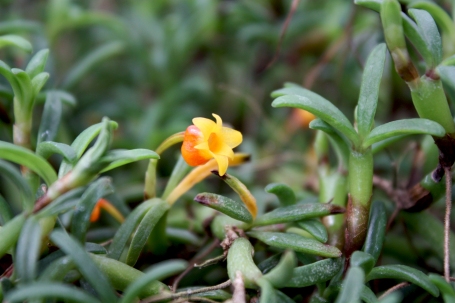
Mediocalcar decoratum
Last but not least is the ever popular Dendrobium secundum, commonly referred to as the Toothbrush Orchid. This often pendulous species is found throughout Southeast Asia. Its inflorescence of bright pink flowers opens successively (but not fully) at the end of a leafless cane giving it the appearance of bristles at the end of a toothbrush handle. The alba form is also quite beautiful with waxy white flowers and a yellow lip.
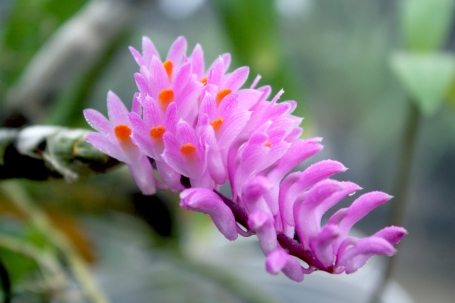
Dendrobium secundum
To see more of our collection, visit the orchid exhibit, Orchids In Focus, at the United States Botanic Garden now through April 17th.
-Julie Rotramel, Orchid Collection Specialist
March 25, 2016 at 8:15 am smithsoniangardens Leave a comment
An Emerging Spectacle: Orchids in Focus at the United States Botanic Garden
The Bletillas are nearly in bloom, and we all know what that means—the annual orchid exhibit is upon us! This week’s post is a special preview of the exhibit, Orchids in Focus, which is produced in partnership between the United States Botanic Garden (USBG) and Smithsonian Gardens and opens this Saturday, February 27 and runs through April 17.
Some of my favorite orchids to photograph are the ones with barely emergent flowers. There is a sense of anticipation in the sight of unfurling petals, like those of the terrestrial Bletilla striata. Developing flowers often display curious shapes that remind us (like so many things) that there is a special beauty in the journey. Brassidiums are some of the best exemplars of this, since their elongated flowers have to unfold from buds that are the size of a fingertip.
Orchids in Focus, which features plants from the Smithsonian Gardens Orchid Collection and the USBG’s collections, is also emerging from its so-called bud. My visit to the conservatory this past Wednesday found a flurry of activity in the East Gallery and finishing touches being put into place in the main Garden Court.
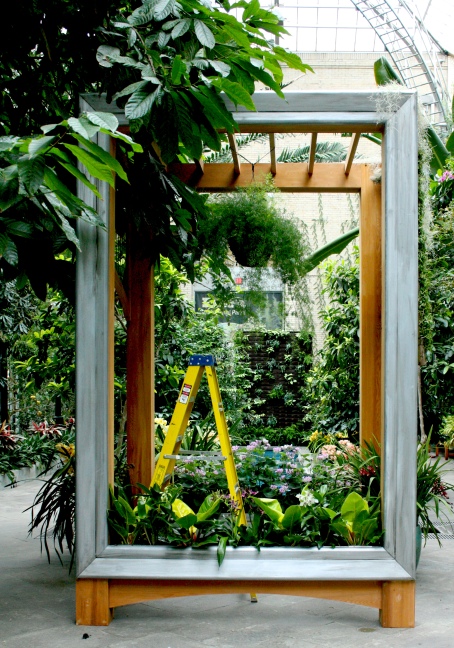
I was able to catch up with a former Smithsonian Gardens intern who is now an orchid grower at the United States Botanic Garden. Justin gave a tour of the work-in-progress and it is clear that it will be quite a spectacle.
The exhibit’s theme highlights orchid photography and is surprisingly interactive since the photography in question is not only images you look at on the walls, but also what YOU take during your visit. Large frames have been constructed in the Garden Court for visitors to pose behind as they are “framed by orchids,” and another station for “orchid selfies” has been designated in front of two exquisite green walls. According to Justin, each side of the green wall takes five hours to build since orchids must be placed individually in the small pockets covering the surface. It sounds like a painstaking process, but the result is magnificent.
The East Gallery houses a tropical forest display which will feature terrestrial orchids from the understory and epiphytic orchids from the canopy on respective sides of the room. Over the next couple of days, USBG staff will be working hard to complete the exhibit, those last few flowers will finish opening, and your job… build anticipation, and get those cameras ready!
–Julie Rotramel, Living Collections Specialist
February 26, 2016 at 9:45 am smithsoniangardens Leave a comment
On Display: Highlights from the Smithsonian Gardens Orchid Collection
One of the best things about working for a botanical garden like Smithsonian Gardens is that part of our mission is to produce splendiferous specimen plants. What makes it even better is that we often get to exhibit these specimens at the peak of their glory!
Alex and Melanie of our interiorscaping staff make sure that many of these extraordinary orchids are on display for the public to see in Smithsonian Gardens’ three display cases at the Smithsonian’s National Museum of American History (NMAH). This week is no exception. A superbly bloomed Cattleya alliance hybrid, Brassocatanthe Julie Morrison (Brassanthe Maikai X Brassocattleya Morning Glory), is almost bursting out of one of the cases!
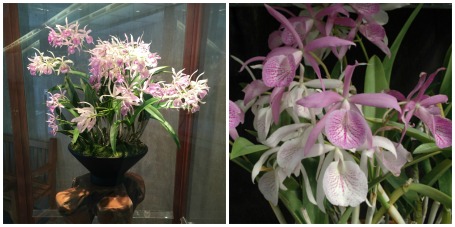
Brassocatanthe Julie Morrison (Brassanthe Maikai X Brassocattleya Morning Glory), Smithsonian Gardens Orchid Collection
This hybrid is a combination of three species from three different genera; the hearty, purple Guarianthe bowringiana which contributes a large flower count and lovely amethyst color; the Cattleya purpurata from Brazil which contributes a large flower size and tremendous vigor to the hybrid; and the fragrant, white Brassavola nodosa.

Top (L to R): Guarianthe bowringiana and Cattleya purpurata, Smithsonian Gardens Orchid Collection Bottom: Brassavola nodosa, Smithsonian Gardens Orchid Collection
Brassavola nodosa may be the least colorful of the hybrid’s three parents, but it displays a tremendous variability. Small, barely-discernable spots deep in this orchid’s lip turn into brilliant, spotted patterns when it is used to create a hybrid with a more colorful species, as in the case of this Brassocatanthe. The flower form of the Brassavola also dominates in this type of breeding. No matter what it is crossed with, the resulting hybrids almost always have narrow segments, spots, and a flaring lip.
Brassavola hybrids are always vigorous and charming with wonderful color and are therefore highly recommended for use in tropical gardens and in home orchid growing. Smithsonian Gardens has several clones of Brassavola hybrids and their species parents in its orchid collection; many of them are displayed at NMAH as they bloom. You can also see these and other beauties from the Smithsonian Gardens Orchid Collection starting February 27, 2016 at this year’s Orchids in Focus exhibition hosted in partnership with the United States Botanic Garden. Stop by and see these glorious orchids if you’re in Washington, D.C.!
– Tom Mirenda, Smithsonian Gardens Orchid Collection Specialist
January 15, 2016 at 9:09 am smithsoniangardens Leave a comment
Beguiling Bulbophyllums: What’s Blooming in the Smithsonian Gardens Orchid Collection
Bulbophyllum is one of the largest orchid genera with around 2,000 species. This genera’s name refers to the leaf-bearing pseudobulbs that are characteristic of plants in this group. An encounter with a Bulbophyllum for the first time can be a rather unexpected olfactory experience, potentially unpleasant, but ultimately a fascinating example of brood site deception between plants and their pollinators.
One of the best examples of the odoriferous Bulbophyllum is Bulbophyllum echinolabium, a beautiful, large-flowered specimen with a putrid and pervasive stink. While the smell makes me want to get away fast rather than stick around to take more photographs, the plant’s fly pollinators are wooed closer by the ripe suggestion of rotting meat. Obviously they are deceived (beguiled, you could say) into pollinating the flower for no reward, and they leave without laying their eggs.
Not all Bulbophyllums exude such a foul odor. Many have a more floral or fruity scent to attract fruit fly pollinators. Others, like Bulbophyllum purpureorhachis ‘Joe Palermo’ have no detectable smell but are equally compelling with impressive rachises of flowers that curve towards the sky like cobras rising from the ground.

Bulbophyllum purpureorhachis ‘Joe Palermo’
Another beautiful specimen in bloom is the otherworldly Bulbophyllum medusa, named after Medusa the Gorgon. The flowers’ sepals have evolved dramatically over time to mimic fungal mycelia which attract fungus gnat pollinators.

Bulbophyllum medusae
It is exceedingly difficult to choose just three Bulbophyllums to feature since there is such a diversity of form and color in this genus. We recently accessioned a large number of Bulbophyllum species into our collection and below are two others I couldn’t leave off this post. Bulbophyllum guttulatum, from section Cirrhopetalum, displays an arc of speckled flowers with bright purple lips. The much larger, green and brown mottled specimen is one of our current mysteries. It could be one of three similar species, B. arfakianum, B. frittilariflorum or B. burfordiense. Each species exhibits wide variation in phenotype, therefore an exact species determination must be made by comparing specific parts of the flower anatomy.

Bulbophyllum guttulatum

Bulbophyllum sp.
There is always something blooming in the Smithsonian Gardens Orchid Collection. Stay connected with us to see more plants from the collection!
-Julie Rotramel, Living Collections Specialist
November 20, 2015 at 10:00 am smithsoniangardens Leave a comment
How the Smithsonian Gardens Tree Collection Benefits the Environment and Our Well-Being
The Smithsonian Gardens Tree Collection currently consists of over 1,900 trees spread across the Smithsonian’s downtown Washington, D.C. campus as well as at the Institution’s support facilities in Maryland. These trees add great aesthetic value to the grounds, and complement the flowers, shrubs, and other plantings in the gardens here. However, and perhaps more importantly, these trees offer a myriad of environmental and health benefits.

Trees along Constitution Avenue at the National Museum of Natural History create a cool, green tunnel for pedestrians. Photo by Greg Huse.
During the summer of 2015, information on all of the collection trees was run through i-Tree, a software program developed by the U.S. Forest Service to calculate the benefits of trees. The results were eye-opening, and it was encouraging to see how much our trees benefit our campus, city, and planet.
Poor air quality, especially in urban areas, can lead to decreased human health, poor visibility, and damage to plants. Trees in urban forests help improve air quality by capturing air pollutants, reducing air temperatures, and decreasing energy consumption in buildings which reduces overall air pollutant amounts by lowering demand on power plants. The SG Tree Collection was calculated to remove 2,700 pounds of air pollutants (carbon monoxide, ozone, nitrogen dioxide, sulfur dioxide, and particulate matter) annually with an associated monetary value of $31,185. This is the equivalent of taking ten cars off the road for a year!

Trees leafing out in spring at the National Museum of Natural History. Photo by Eric Long.
One of the most important environmental challenges we currently face is global climate change. Trees can help mitigate this problem by capturing atmospheric carbon and storing, or sequestering, it for many years. As trees grow, they continually store carbon in the new wood they produce. The trees in the SG Tree Collection store an estimated 37,877 pounds of carbon annually. The large majestic oaks, elms, and other trees found at the National Museum of American History sequester twice as much carbon as the trees found in any other Smithsonian garden or landscape.
Surface runoff of stormwater is a cause for concern in urban areas because it can contribute to pollution in streams, rivers, lakes, wetlands, and oceans. Precipitation that reaches the ground and does not infiltrate the soil becomes surface runoff, which carries pollutants into waterways. Urban trees reduce this runoff by intercepting the water in the tree canopy and allowing it to evaporate over time. Additionally, water that lands on trees may run along the branches and down the trunks which helps it reach the ground more slowly and infiltrate the soil. Smithsonian trees intercept 383,705 gallons of rainfall annually, thereby preventing it from becoming surface runoff.
In addition to these environmental benefits, many recent studies show how trees, especially in urban areas, contribute to better health for people. Areas that have many trees can lower blood pressure, have a calming effect on teens and adults with ADHD, improve breathing for those with asthma and other lung conditions, decrease healing times for sickness and injury, contribute to overall emotional and psychological health, and even improve birthweights of newborns!

An oak transformed by autumn color at the National Air and Space Museum. Photo by Greg Huse.
We appreciate trees for their beauty and grandeur, especially at this time of year when they come ablaze with autumn colors. Beyond appreciating their beauty, it’s important to remember all of the environmental and health benefits they provide as well. Planting and properly maintaining trees are important steps to take to continue to improve the world in which we live. We here at Smithsonian Gardens are proud to do our part in contributing to that goal.
– Greg Huse, Smithsonian Gardens Arborist and Tree Collection Manager
Rare and Beautiful Orchids (and a Horticulturist) Find Home at Smithsonian Gardens
Imagine opening an innocuous cardboard box and finding this inside!
I was fortunate to have this pleasure on one of my first days on the job as a horticulturist with Smithsonian Gardens. Already amazed (and slightly overwhelmed) by the diversity of orchids in the Smithsonian Gardens Orchid Collection, my first week on the job included helping my colleagues unpack a tractor trailer full of boxes containing a major donation of orchids.

Anne, a Smithsonian Gardens volunteer, assists Emily and the other greenhouse staff unpack boxes of donated orchids.
Hundreds of specimens were added to the orchid collection at the Smithsonian Gardens Greenhouse Facility in Suitland, MD. The plants were part of an extensive collection owned by the late Denis Roessiger of Penobscot, ME, that have been generously donated by his wife, Lucybelle.
Horticulturists from the Smithsonian Gardens greenhouses journeyed to Maine to select and carefully pack up the orchids, which then travelled overnight by truck to the Suitland greenhouse facility. There, greenhouse staff and volunteers eagerly unloaded and unpacked the vast array of plants. “This donation is exceptional in that 99% of the orchids are species orchids or rare hybrids,” commented Smithsonian Gardens Orchid Specialist, Tom Mirenda. The donation is a major addition to the Smithsonian Gardens’ collection, adding entirely new genera to it and increasing the species abundance and overall diversity.
I asked Tom Mirenda to give me a walk-through of the highlights of the donation. Here are his top picks:

(L to R) Bulbophyllum amplebracteatum subsp. carunculatum ‘Sunset Valley Orchids’ and Bulbophyllum cocoinum
Over 200 new Bulbophyllum specimens now complement the already extensive collection of this genus maintained by Smithsonian Gardens. Bulbophyllum is one of the largest and most ancient genus of orchids; found in tropical forests around the world, they are often odd-looking plants with peculiar, sometimes foul, fragrances. “One of my favorites currently in bloom is Bulbophyllum cocoinum, which has a coconut fragrance,” says Mirenda. The donation also included fifteen species of Trichoceros, a new genus for the collection. Trichoceros are epiphytic and terrestrial orchids native to the Andean Mountain range in South America.
The donation tripled Smithsonian Gardens’ collection of hard to find Maxillaria orchids, and added 50 to 70 species of Restrepia and several large specimen Coelogyne and Dendrochilum. Also new to the collection are several Lycaste and Dracula species. Rare color forms of Laelia and Cattleya now grace the collection. Orchid enthusiasts will swoon at the large addition of South American Slipper Orchids (Phragmipedium), particularly the controversial Phragmipedium kovachii—the orchid at the heart of the book, Scent of a Scandal.
Large, brilliant, purple flowers of an eight-foot Vanda were one of the showiest surprises during unpacking. One of the Smithsonian greenhouses has been transformed with the addition of roughly 40 Vandas now hanging from the ceiling and suspended racks.
With the acquisition of these plants, our orchid collection now has well over 10,000 specimens. “By continually building our collection in this way, we have made the Smithsonian Gardens Orchid Collection a true scientific resource,” says Mirenda.
– Emily Cook, Horticulturist, Smithsonian Gardens
A Spectacular Show: What’s Blooming in the Smithsonian Gardens Orchid Collection
The sight of fresh blooming encyclias is one to tease the eyes. Generally small flowered and often less than an inch in diameter, encyclias pack a punch with their unending shape and color variations. Orchid lovers could spend days observing these species and hybrids. This hardly comes as a surprise when you take into consideration that there are over 150 species in the genus.

Encyclia Nursery Rhyme
Originating from the Greek word, enkylein, the name encyclia refers to the way the lateral lobes of the flower encircle the column. Found from central Florida to Brazil, these orchids grow in warmer climates and produce psuedobulbs in clumps. Each clump sends up several flower spikes at a time and each variety of encyclia has flower spikes that range in a length from a foot to several feet long. Since each spike can produce many flowers these spikes make for quite a spectacular show.

A clustering of Encyclia oncidioides behind Encyclia Cindy.
I find these orchids very pleasing to observe. Their small flowers make them manageable to view, but contain subtle details that are a delight to discover. These flowers have great depth to them, so changing your angle of view can reveal more interesting characteristics.
Encyclias are often crossed with the genera Cattleya and Epidendrum to create lovely hybrids. Encyclias are desirable for their interesting flower shapes and Encyclia cordigera in particular often is selected for hybridization for its darker colors and intoxicating aroma. Encyclia cordigera has received over 40 awards from the American Orchid Society, so why not pass along some of these winning characteristics to other orchids?

Encyclia Atroniceum x bractescens

Encyclia alata x mooreana
In the Smithsonian Gardens Orchid Collection, there are currently over 60 examples of these encyclia species and hybrid combinations. Their flowers last up to a month sometimes longer, so they regularly make their way to the display cases in museums around the Smithsonian. Be sure to swing by the orchid cases downstairs in the National Museum of American History sometime in the next few weeks to see one of these incredible orchids on display.
– Alan Marcus, Smithsonian Gardens Orchid Intern

Encyclia Cindy
Matt’s Top 5 Tropicals for 2015
The Smithsonian Gardens’ tropical plant collection includes approximately 1,000 plants. This number fluctuates on a fairly regular basis as some plants die from natural causes while others grow so large that they outgrow their display space or even the Smithsonian Gardens’ greenhouse facility. As the caretaker of this collection, I have a special relationship with the plants and, though I care for them all, I do have a few favorites. Here is a list of my personal top 5 favorite plants in the Smithsonian’s tropical plant collection (in no particular order) along with where to catch them on display this summer.
First up is Caladium schomburgkii ‘Skula.’ This relatively unknown caladium is subtle, but for some reason is a favorite of mine. Could it be the interesting leaf shape, or perhaps its various hues of green leaves, or simply its ease of care? I honestly don’t know why I like this plant so much but see for yourself and make your own decision. Location: Enid A. Haupt Garden
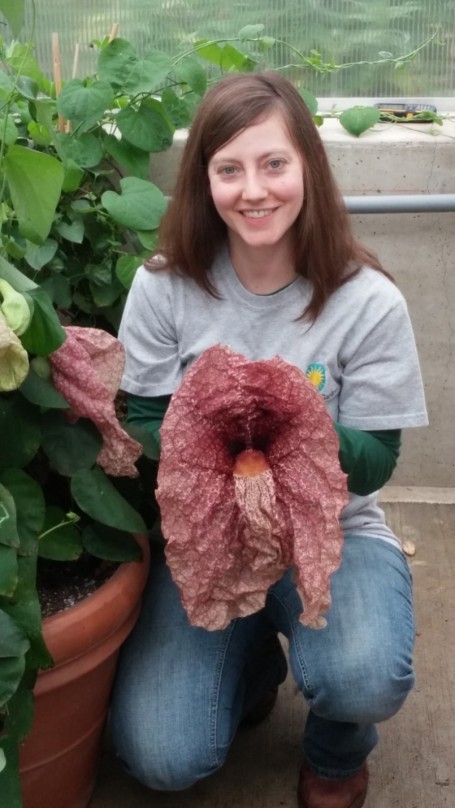
Aristolochia gigantea ‘Brasiliensis.’ My coworker, Shannon, was kind enough to pose with the flower to give you an idea of its size.
Once you see Aristolochia gigantea ‘Brasiliensis’ flowers you will know why this tropical made my top 5 list. It took me a few tries to cultivate this plant. I previously obtained two specimens and both times when they flowered they ended up being straight A. gigantea. My third attempt was well worth the trouble, however. This plant produces flowers nearly year-round and what a display they make! The flowers measure nearly 12 inches wide and before opening they have a fascinating side profile that resembles a smoking pipe. Aristolochia ridicula was close to making my list as well (check out its flowers). Location: Mary Livingston Ripley Garden
Dioscorea mexicana, also called Mexican Yam, is one of the coolest looking plants you will ever see. The plant’s caudex (stem base) looks like a tortoise shell. The glossy heart-shaped leaves are attractive and can grow 15 feet in a single growing season. While pretty, the flowers are small so it’s best to enjoy this plant for its foliage and oh so interesting caudex. Location: Enid A. Haupt Garden
Combretum indicum ‘Flora Plena,’ the second vine on my list, is certainly a show stopper. This doubled flowered cultivar is not only visually breathtaking but also pleasantly fragrant. The flowers start out white and as they age change over to various hues of pink and red. Location: Enid A. Haupt Garden
Alsobia dianthiflora is also known by its common name, Lace Flower. A simple plant with fuzzy green leaves and a dark midrib, it looks nice year-round but really shines when it’s shredded-edged white flowers start to bloom. This plant also makes for a great house plant. Location: Enid A. Haupt Garden
A bonus plant to add to this list is expected to make its appearance in the Smithsonian Gardens during the summer of 2016 or 2017. Encephalartos horridus is an amazing blue cycad. I acquired a small offset in the fall of 2012 and have been caring for it ever since. The International Union for Conservation of Nature lists this plant as Endangered. It is native to South Africa. E. horridus has spectacular blue fronds that make it a truly special specimen.
So there you have it–my current top 5 plants under my care here at Smithsonian Gardens. I hope you enjoy them as much as I do and please stop by our gardens and check them out in person if you have a chance.
– Matt Fleming, Smithsonian Gardens Horticulturist











